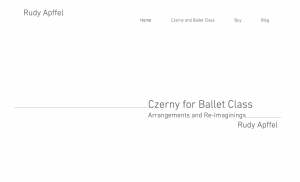Absolutely thrilled to discover Rudy Apfells’ Czerny for Ballet Class blog — lovely recordings of huge numbers of Czerny exercises, together with reimaginings/reworkings of them (see here for a description of the project) lots of interesting commentary, and downloadable scores.
Not content with just one reworking, some exercises, like Op 335 No. 6 have six.
In the wrong hands (what a great metaphor for a pianist-related post!) this kind of music can sound so drab, just the kind of thing that should be banned from ballet classes forever. But Apffel’s reworkings are witty and clever, and hold a mirror back to the original that make you hear it differently. There’s one in the style of Prokofiev’s “Dance of the Knights,” for example, but my favourite is the jazz waltz rendering. If you didn’t know it was based on Czerny, you could believe it had been a No. 1 chanson in Paris in the 1950s. Sometimes when you come to rearrange things like this you realize that the underlying composition is cleverer than you realized, obscured by a patina of tired familiarity.
This is such a magnificent labour of love, but I fully understand Apffel’s fascination with Czerny. I think it’s Taruskin who said that there are two Beethovens (or Bachs? Or Mozarts?—I’ll correct this if I’m wrong another time) —there’s Beethoven, and “Beethoven.” The one in scare quotes is the composer that comes with all the baggage—the music appreciation classes you hated, the feeling that you had to like the music even if you didn’t, the way that people look in concert halls as they’re listening to his music. Without the scare quotes, you might feel quite differently about the music (for good or ill, as it happens, with some of the great names).
Likewise, with Czerny: there’s Czerny the fun composer, Czerny the man who worked like crazy, with so many simultaneous projects on the go that he reputedly set them all out on different desks in his study, spending an hour at each in succession in order to make progress on them all (even if the story isn’t true, I love it); Czerny whose exercises dance and sing and convey drama. Then there’s “Czerny,” the scourge of young pianists, who are handed the books of exercises as if they were not really music, but “merely” technical machines to improve technique, like those things 19th dancers used to splay their feet in to improve their turnout. “Czerny” the abandoned sheet music in the Oxfam shop, with a stained cover, musty smell, and pencilled ticks and music teachers’ fingerings in. I feel sick just thinking about it.
Take away the scare quotes, and there’s a joyful, imaginative composer here with a staggering wealth of material, and that’s what Rudy Apffel is mining with his new arrangements and reimaginings. There’s a danger that you might miss Apffel’s humour and ingenuity if you just turn on a single track and think “I wonder if I could use this for tendus?” Get inside the music, listen to them as a series, compare one with the other, and this is a wonderful musical journey. One of the things I especially like is the use of technology to do the impossible—freely admitted by Apffel!— as in this Schubert-Impromptu-Meets-Czerny-Op 335 No. 18.




mr still, your writer’s gift is delightful, dark and deep:
“Czerny” the abandoned sheet music in the Oxfam shop, with a stained cover, musty smell, and pencilled ticks and music teachers’ fingerings in. I feel sick just thinking about it.
You’re too kind!